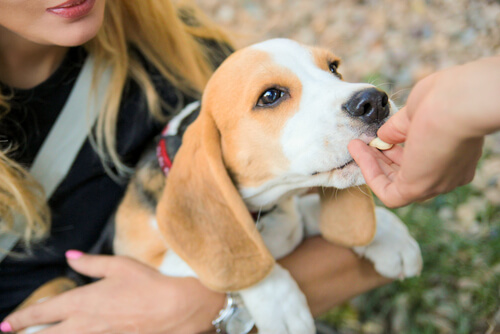How to Clean Sleep from your Dog’s Eyes


Written and verified by the lawyer Francisco María García
It is not just a question of hygiene. Getting into the daily habit of cleaning the sleep out of your dog’s eyes can prevent eye problems such as conjunctivitis.
Eye care and eye dust removal is essential. This prevents dirt particles from impacting the dog’s eyes. If these particles continue, the animals can get an infection.
The method of the dog’s eye care depends on the type of dog. For example, those with bulging eyes need more care.
Differences between dog’s sleep dust

- The discharge that is considered “normal” is the kind that a dog can get after a few hours of sleep. To remove them, it is best to use dry gauze over the edge of the animal’s eye.
In cases where they are a little hard, it is best to soak the gauze in a little warm water to soften it. In other cases, you can use a special wipe for dogs.
- If our pet’s eyes are red and the eye dust is green and hard, it may be the sign that there is an infection, It could be a minor eye infection or even conjunctivitis.
If this happens, it is best to go directly to the veterinarian to treat the infection. Never try to solve it with home treatments like serums or other remedies.
In the latter case, the ocular problem could be aggravated.
Depending on the breed
In some short-nosed breeds, tears and discharge are introduced into the folds of the skin. Here, you will need to do a deep cleaning of these folds. This is the case, for example, with some breeds like the Shitzu and the Pekingese.
In these short-haired dogs, it is advisable that they always keep their eyes clear. You have to keep their hair out of their eyes (you can help with a rubber band). And they also need a frequent trimming of the hairs around the eyes.
It is necessary to rely on a small comb and round-tipped scissors to often comb and to trim the hairs between the eyes and around the muzzle so they never get into its eyes.
In doing this, we will also avoid our friend trying to scratch the area with his claws when he feels itching or discomfort. This is something that often causes many complications.
Hygiene from a young age
The advisable thing is that we acclimate our dogs to this routine from a young age. That way we will avoid them getting nervous when cleaning. It is important that we show tranquility and serenity, to calm the dog and to make the process appear like something natural and daily.
When you’re removing the sleep dust …
The proper process is to immerse a piece of gauze in a special saline solution for cleaning human or dog’s eyes or in warm chamomile. We will slide gently from top to bottom over its eyes, removing the dirt bit by bit.
It is always preferable to do so gently. This has to be repeated several times so that the eyes are very clean. This will be better than doing it once brusquely.
When we have removed the discharge from one eye, we will repeat the process with the other, but we will use a new gauze for this. That way, we will avoid the risk of any transmitting possible infections from one eye to the other.
Ideally the eye cleaning will be done twice a week, unless it is a breed prone to accumulating sleep and dirt, or if your pet has previous eye problems.
If these problems exist, our dog’s eyes should be cleaned daily.
The award

When we finish eliminating the legañas, it is very positive to give a prize to the dog. In this way, the animal will begin to associate eye cleanliness with something positive that brings a good reward, assimilating the process better and better.
Some eye diseases
If we observe that the dog always appears dirty and the eyes are full of discharge, it is possible that our pet suffers from a syndrome of always dirty eyes. This disease is common in dogs that tend to lack sufficient tear secretion, like cocker spaniels.
By means of a simple consultation with the veterinarian, it will be possible to solve this problem that often occurs in these creatures.
This text is provided for informational purposes only and does not replace consultation with a professional. If in doubt, consult your specialist.